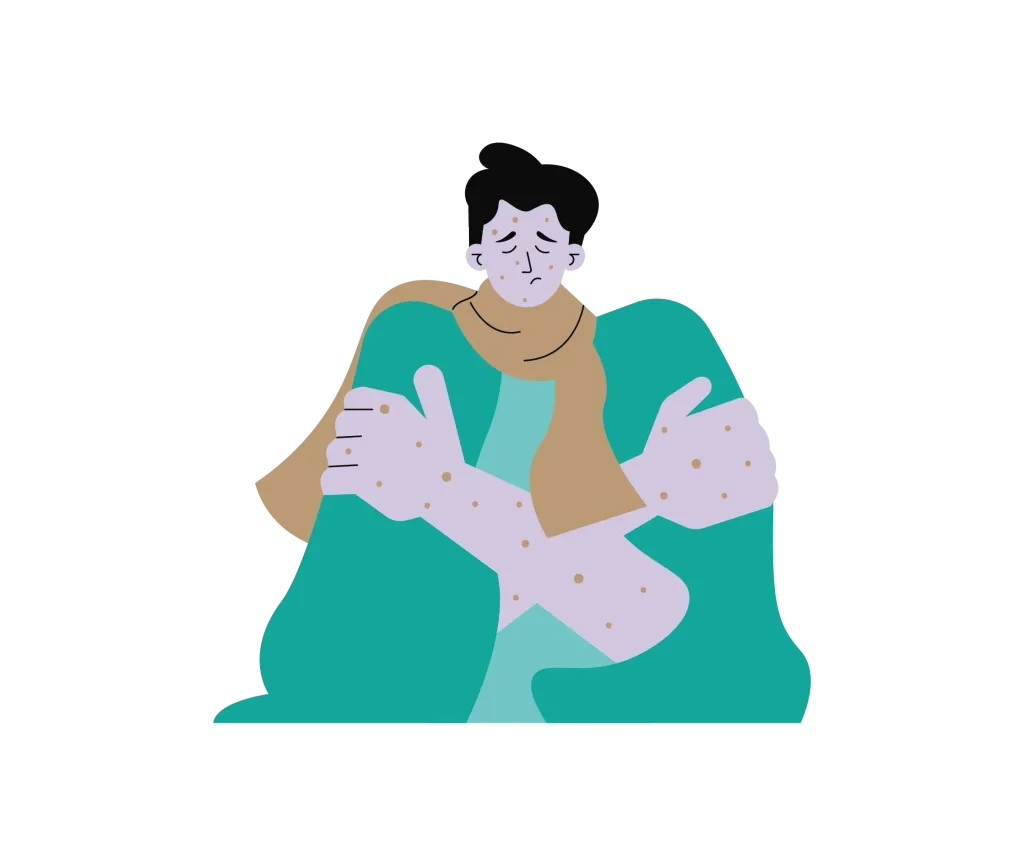Allergist's appointment
Redness of the skin, lacrimation, sneezing are allergy symptoms, in which you should make an appointment with an allergist. A specialist will evaluate the symptoms, prescribe tests and select an effective treatment.

Allergies can be caused by a variety of factors, including pollen, food, medications, and dust. Understanding the causes and mechanisms of allergy allows you to effectively manage it and avoid complications.
Benefits
Individual approach
Treatment and recommendations are selected taking into account the characteristics of the patient.
Professional expertise
A highly qualified allergist uses the latest scientific data for treatment.
Comprehensive analysis
The use of various diagnostic approaches to accurately identify allergens.
Preventing complications
Timely referral to a specialist helps to avoid complications associated with allergies.
Frequently Asked Questions
Didn't find an answer to your question?
You can ask a doctor to answer your question in detail, he will answer you and help you solve the problem
Ask a doctorIn what cases is it necessary to contact a specialist?
01
Symptoms of asthma or pollinosis
Shortness of breath, coughing at night or after exercise, shortness of breath.
02
Seasonal manifestations
If the symptoms appear seasonally and last several months of the year.
03
Family history of allergies
If several members of your family have allergic diseases.

Preparation
No special training is required, but before visiting an allergist, it will not be superfluous to keep a diary of nutrition and reactions, as well as collect information about previously used medications and past allergic reactions.

Consultation with an allergist
The doctor will examine your medical history, including symptoms, their seasonality and reaction to foods, as well as the history of allergic reactions in your family. After that, tests can be prescribed to determine allergens. Depending on the symptoms, instrumental examinations may be prescribed: rhinoscopy, spirometry or radiography. After consultation, the allergist will give recommendations on allergy management, including medication.
Doctors
Select clinics
- Multi-field health center
- Olympus Clinic Sadovaya
- Олимп Клиник Огни
Area
- All areas
- Plastic surgery
- Cosmetology
- Dentistry
- Gynecology
- Maxillofacial Surgery
- Phlebology
- Otorhinolaryngology
- Surgery
- Traumatology and orthopedics
- Therapy
- Anesthesiology-Intensive Care
- Allergology and immunology
- Gastroenterology
- Dermatology
- Cardiology
- Coloproctology
- Radiation diagnostics
- Neurology
- Ophthalmology
- pediatrics
- Psychology
- Rehabilitation
- Rheumatology
- Ultrasound examination
- Urology
- Psychiatry and psychotherapy
- Endocrinology

Indications and contraindications
Indications
Frequent allergic reactions
If you encounter regular manifestations of allergies that interfere with daily life.
Severe reactions
The presence of anaphylactic reactions or other serious allergic symptoms.
Ineffectiveness of standard treatment
If conventional treatments do not bring relief.
Undefined triggers
When it is necessary to find out the triggers of an allergic reaction.
Useful information
Area
- All areas
- Plastic surgery
- Cosmetology
- Dentistry
- Gynecology
- Maxillofacial Surgery
- Phlebology
- Otorhinolaryngology
- Surgery
- Traumatology and orthopedics
- Therapy
- Anesthesiology-Intensive Care
- Allergology and immunology
- Gastroenterology
- Dermatology
- Cardiology
- Coloproctology
- Radiation diagnostics
- Neurology
- Ophthalmology
- pediatrics
- Psychology
- Rehabilitation
- Rheumatology
- Ultrasound examination
- Urology
- Psychiatry and psychotherapy
- Endocrinology
Specialist
- All specialists
- Korolev Andrey Vadimovich
- Agapov Denis Genrikhovich
- Babin Vyacheslav Vyacheslavovich
- Pavel Ermolaev
- Zabnkova Olga Vladimirovna
- Velichko Konstantin Vladimirovich
- Malakhov Alexander Andreevich
- Lubnin Dmitry Mikhailovich
- Nikolaeva Elena Viktorovna
- Chernysheva Yulia Viktorovna
- Almazov Ilya Alekseyevich
- Terezanov Oleg Yuryevich
- Frolov Alexander Vladimirovich
- Abdumavlanov Azamat Abdulievich
- Abramashvili Sofya Davidovna
- Avanesyants Sofya Igorevna
- Averbukh Vladimir Mikhailovich
- Airapetova Isabella Leonidovna
- Aksenova Ekaterina Lvovna
- Allakhverdieva Ramila Kamalovna
- Olesya Anatolyevna
- Arakelyan Albert Hovhannesovich
- Arevina Victoria Evgenievna
- Artamonov Artem Alexandrovich
- Babina Irina Alexandrovna
- Baysieva Asiyat Mukhamedovna
- Anastasia Andreevna Beburishvili
- Beloborodova Liliya
- Bogdanova Alexandra Andreevna
- Borisenko Yana Yurievna
- Borisova Polina Olegovna
- Nikita Dmitrievich Bubenin
- Bugakova Anna Sergeevna
- Buravlev Bogdan Nikolaevich
- Vaniev Boris Mirabovich
- Vasiliev Fedor Vyacheslavovich
- Vegra Ekaterina Vasilievna
- Koroleva Irina Valerievna
- Vitebsk Alice Vitalievna
- Gazimieva Bella Magomedovna
- Gvozdeva Anastasia Vladimirovna
- Grechishnikov Mikhail Igorevich
- Darginskaya Lyubov Yurievna
- Jafarova Amina
- Dushevskaya Ekaterina Alekseevna
- Evseychik Olga Nikolaevna
- Emelyanova Tatyana Georgievna
- Ermolaeva Anastasia Viktorovna
- Erokhina Yulia Sergeevna
- Zhilin Viktor Olegovich
- Zhumanov Andrey Rudolfovich
- Zavolovich Julia Dmitrievna
- Zaitsev Sergey Yuryevich
- Zakroyshchikova Inessa Vladimirovna
- Zaripov Aziz Rimovich
- Alexey Vladimirovich is healthy
- Ilyin Dmitry Olegovich
- Kalinina Ekaterina
- Kalyadin Vladimir Anatolyevich
- Karpushin Grigory Alexandrovich
- Kastueva Alsu Vagizovna
- Kashevarova Stanislava Sergeevna
- Kirichenko Olga Andreevna
- Klimenkov Georgy Sergeevich
- Knutarev Stepan Sergeevich
- Kovalev Valentin Sergeevich
- Kozlova Alexandra Olegovna
- Korovashkova Karina
- Kosachenko Mikhail
- Krupyanko Sofya Mikhailovna
- Kuznetsova Alina
- Kuznetsov Dmitriy
- Kuznetsov Pavel Andreevich
- Kungurtseva Anastasia Leonidovna
- Kurakin Konstantin Alexandrovich
- Kurenkov Andrey Vladimirovich
- Denis Ivanovich Laseev
- Latypova Yulia
- Latyshev Alexander Vasilievich
- Leval Pulad Shah-Zarovich
- Logvinov Alexey Nikolaevich
- Loginova Darya Alekseevna
- Lozovsky Alexander Vladimirovich
- Lomaka Irina Borisovna
- Lych Stanislav Vladimirovich
- Lvova Tatiana Sergeevna
- Lyashev Ilya Nikolaevich
- Mavlieva Radmila Ruslanovna
- Magomedova Madina Magomedovna
- Maivandi Elena Dmitrievna
- Mayskova Irina Yurievna
- Maksimenko Maria Alexandrovna
- Malakhov Igor Mikhailovich
- Markova Alina Igorevna
- Melentyev Alexander Alexandrovich
- Miroshnichenko Andrey Petrovich
- Monaenkova Maria Kirillovna
- Moskalenko Anna Nikolaevna
- Mushenko Vladislav Alekseevich
- Neznanov Igor Valentinovich
- Nekrasova Lyubov Yurievna
- Nemanov Boris Alexandrovich
- Nikitin Denis
- Novitsky Vadim Evgenievich
- Olimpeva Anastasia Sergeevna
- Pavlichenko Svetlana Nikolaevna
- Pavshintseva Elena Sergeevna
- Pavel Yuryevich Parshin
- Podzolkova Vera Alekseevna
- Polner Maria Sergeevna
- Polyakova Naira Andreevna
- Pryanikov Pavel Dmitrievich
- Pugacheva Elena Nikolaevna
- Razdobudko Inna Gennadievna
- Rogatkin Petr Sergeevich
- Romanova Olga Ivanovna
- Igor M Romanovsky
- Rudaya Anna Ivanovna
- Rukavitsina Tatiana Grigorievna
- Rybalkina Alina Alimzhanovna
- Rychkova Maria Andreevna
- Ryabova Anna Valerievna
- Ryazantsev Mikhail Sergeevich
- Savinova (Vedenina) Valentina Evgenievna
- Sanosyan Lena Samvelovna
- Sas (Artyukhina) Svetlana Lvovna
- Maxim E. Sautin
- Sakharova Tatyana Valeryevna
- Sviridonova Marina Alexandrovna
- Severova Anna Gennadievna
- Selivanova Anastasiia
- Serdobintsev Kirill Valentinovich
- Serova (Kachurina) Vera Sergeevna
- Slivko Mikhail Pavlovich
- Smirnov Alexey Vladimirovich
- Sonova, Marina Musabievna
- Tarasov Vladimir Alexandrovich
- Tereshchenko Ekaterina Sergeevna
- Timokhina Natalia Albertovna
- Tymoshenko Kristina Viktorovna
- Tirsi Karim Alievich
- Titareva Alexandra Sergeevna
- Titova Yana Olegovna
- Tikhov Andrey Sergeevich
- Mikhail Toporov
- Treyman Elena Vladimirovna
- Trill Diana Vladimirovna
- Trushina Anna Alekseevna
- Tumilovich Taisiya Alexandrovna
- Urtenov Radmir Dagirovich Urtenov
- Andrey A. Uchevatkin
- Filin Nikolai Andreevich
- Khasia Eliso Mikhailovna
- Khachatryan Meline Sarkisovna
- Khrustaleva Irina Eduardovna
- Khinku Ekaterina Eduardovna
- Chagava Dmitry Alekseevich
- Chekeneva Natalya
- Chekmareva Irina Alexandrovna
- Cherepanin Ivan Andreevich
- Chibisov Nikita Sergeevich
- Chuprikov Roman Sergeevich
- Shalimova Inessa Gennadievna
- Sharov Ilya
- Shautina Marina Sergeevna
- Shvetsova Tatyana Alekseevna
- Ekazheva Marianna Solekhovna
- Etingof Anna Mikhailovna
- Yakovleva Olga Gennadyevna
- Yaltonskaya Polina Andreevna
Chronic sinusitis
Inflammation of the mucous membrane of the paranasal sinuses, which lasts more than 12 weeks. The condition causes prolonged nasal congestion, which may be accompanied by nasal discharge or pass without it. Headaches and a feeling of pressure in the affected sinus area are also possible.
Volumetric formations of the nasopharynx
Pathological changes in nasopharyngeal tissues, including benign nasopharyngeal tumors such as polyps, cysts, adenomas and angiofibromas, can significantly affect breathing, hearing and sense of smell. Malignant tumors of the nasopharynx also pose a serious threat to health.
Thornwald's Bag
This is a benign congenital cyst-like formation that is located on the back wall of the nasopharynx.
Curvature of the nasal septum
This is a deviation of the nasal septum from the midline, which can cause difficulty in nasal breathing and contribute to the development of chronic diseases of the nose and paranasal sinuses.
Facial reconstruction after injuries
Facial reconstruction after injuries is a complex of operations aimed at restoring the usual appearance and functionality of facial structures after fractures of facial bones, cuts and burns.
Adenoids
Adenoids are an accumulation of lymphoepithelial tissue located in the dome of the nasopharynx (nasopharyngeal tonsil). Adenoids are part of the lymphoepithelial ring, consisting of six tonsils, which plays a key role in protecting the body from infections.
Expected effect
Accurate diagnosis
Identification of allergens, which allows you to accurately prescribe treatment.
Relief of symptoms
Selection of treatment and prevention to minimize the manifestations of allergies.
Understanding Triggers
Identification of the factors that cause allergic reactions, which helps to avoid them in the future.
Improving the quality of life
Reducing the frequency and intensity of allergic reactions.
Similar referral activities
Select clinics
- Multi-field health center
- Olympus Clinic Sadovaya
- Олимп Клиник Огни
Area
- All areas
- Plastic surgery
- Cosmetology
- Dentistry
- Gynecology
- Maxillofacial Surgery
- Phlebology
- Otorhinolaryngology
- Surgery
- Traumatology and orthopedics
- Therapy
- Anesthesiology-Intensive Care
- Allergology and immunology
- Gastroenterology
- Dermatology
- Cardiology
- Coloproctology
- Radiation diagnostics
- Neurology
- Ophthalmology
- pediatrics
- Psychology
- Rehabilitation
- Rheumatology
- Ultrasound examination
- Urology
- Psychiatry and psychotherapy
- Endocrinology
Select categories
- Pediatric orthodontics
- Injection cosmetology
- Hardware cosmetology
- Aesthetic cosmetology
- Body aesthetics
- Thread lifting
- Rehabilitation
- Advisory cosmetology
- Hardware gynecology
- Biorevitalization
- Bracket systems
- All allergology and immunology services
- All gastroenterology services
- All dermatology services
- All cardiology services
- All coloproctology services
- All radiation diagnostic services
- All Neurology services
- All pediatrics services
- All services of psychiatry and psychotherapy
- All psychology services
- All rheumatology services
- All dental services
- All ultrasound diagnostic services
- All urology services
- All phlebology services
- All surgery services
- All services of maxillofacial surgery
- All endocrinology services
- Diagnostics
- Dental implants
- Injection gynecology
- Consultation
- Dental treatment
- Manipulations
- Traumatology manipulations
- Surgical interventions
- Surgical interventions in traumatology
- Department of Super Aesthetics
- Department of therapy
- Breast plastic
- Face plastic
- Body plastic
- Plastic surgery
- Prosthetics
- Professional care
- Nasal procedures
- Others gynecology services
- Tooth extraction
- Anesthesiology and resuscitation services
- Ophthalmology services
- Surgical gynecology
- Soft tissue surgery
- Aligners
Allergist's appointment
Redness of the skin, lacrimation, sneezing are allergy symptoms, in which you should make an appointment with an allergist. A specialist will evaluate the symptoms, prescribe tests and select an effective treatment.
News and Media
How to reach
Moscow. 1-st Yamskogo Polya Street, 15
Mn-Sn 08:00-20:00
+7 495 255-50-03
How to get
From the Belorusskaya metro station of the Zamoskvoretskaya line - exit 4 After exiting the subway, walk through the pedestrian tunnel and climb the stairs. Move towards the railway tracks, go down the stairs immediately after them and walk along the house, then turn right onto 1st Yamskoye Pole Street. At the turn to 3rd Yamsky Pole Street, cross the road at the pedestrian crossing and continue along 1st Yamsky Field Street, after a few buildings on the left you will see Olympus Clinic MARS
Travel time
9 minutes
Landmark
Olympus Clinic MARS sign
How to get
From the Belorusskaya metro station of the Ring line - exit 2. After exiting the subway, turn left and walk to the pedestrian crossing. Cross the road through two pedestrian crossings and move along the Tverskoy overpass. Go down the stairs immediately after the railway tracks, walk along the house, then turn right onto 1st Yamskoye Pole Street. At the turn to 3rd Yamsky Pole Street, cross the road at the pedestrian crossing and continue along 1st Yamsky Field Street, after a few buildings on the left you will see Olympus Clinic MARS
Travel time
11 minutes
Landmark
Olympus Clinic MARS sign



